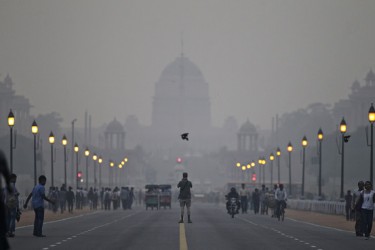Why Delhi is the perfect air pollution case study

By Dr Anthony Horton
A recent article published in the journal Atmospheric Environment has illustrated why air pollution is a multi-factorial issue that shouldn’t be ignored amongst the excitement and anticipation of the United Nations Climate Change conference in Paris starting in only 7 days. Prashant Kumar from the University of Surrey Faculty of Engineering and Physical Sciences led a team of researchers in a study that highlighted the importance of unregulated and unaccounted primary pollution sources (those that emit pollution directly into the air) in and around Delhi. In addition, the research discussed the challenges associated with developing effective air pollution control strategies. This year Delhi has been ranked fifth out of the 32 mega cities in the world in terms of population (approximately 26 million).
In addition to unregulated and accounted pollution sources within Delhi, there are a number of other factors that contribute to air pollution in the city. Sources in areas surrounding the perimeter of Delhi (to which the city’s regulations don’t apply), geography and regional meteorology all contribute to the reality of air pollution. Regional meteorology results in a number of phenomena that influence Delhi’s air pollution including high winds and dusty conditions in summer being emphasised by low relative humidity conditions which enhance the re-suspension of particles, episodic dust transport events from nearby areas, background ozone concentrations and long range transport of precursor emissions from subcontinental and intercontinental sources.
As a result of Delhi’s geography, air (sometimes more polluted than in Delhi itself) moves into the city from surrounding areas. Being land locked, there are few opportunities to flush polluted air out or to replace it with cleaner air from maritime regions, and this puts Delhi at a distinct disadvantage. Delhi shares this characteristic with growing mega cities such as Tehran and Cairo in which urban growth is increasingly heterogeneous and sometimes unplanned. In contrast, mega cities close to the coast benefit from sea breezes that exchange maritime and urban air once each day.
Urban environments typically have a diverse range of co-existing sources and it is important to understand their location and emission intensity in order to develop abatement measures and for predictive/forecasting purposes. In developing countries, such knowledge is reasonable, however there is a general lack of high quality spatially dis-aggregated primary emissions inventories for many mega cities including Delhi. As a result, emissions factors become inadequate or outdated and unaccounted and unregulated sources are often left out of inventories.
Emission inventory and source apportionment studies typically include emissions from on road vehicles, power plants and the re-suspension of particulates, however city specific sources are sometimes left out. Important sources for Delhi include brick kilns fuelled by raw wood, agricultural waste or poor quality coal, the roadside burning of organic and plastic waste, the unintentional burning of municipal solid waste at landfills and construction activities.
Cooking by the burning of solid biomass or cow dung is another important but poorly quantified air pollution source that emits gaseous and particulate pollutants. Direct evidence of the incomplete combustion of biomass and soot/organic carbon emissions is seen in the black colour of the “Chulla cook stove”. Diesel generators for temporary power generation have been considered in some emissions inventories in India such as the Six Cities Program of the Central Pollution Control Board in India. In areas of poor power network resilience or under-supply, diesel generators are particularly important.
In terms of Delhi, diesel generators become very important in extreme summer and winter weather conditions. They tend to be fuelled by poorer quality diesel with a high sulphur content and may not be regularly serviced. Their emissions (including nitrogen oxides, carbon monoxide, hydrocarbons, particulates and smoke) may also not be checked by regulators. Traffic congestion is a ubiquitous air pollution source in cities, and in Delhi it is emphasised by the very high density activities and limited infrastructure in the city. Emissions at traffic intersections are made worse by poor exhaust control measures and the heterogeneous nature of the fleet. Unregulated small industries use a variety of energy sources (eg. biomass, plastic and crude oil) that are often not accounted for in existing inventories.
A number of small and household industries moved away from Delhi city following the implementation of the Indian Supreme Court orders in 1996, however they are still included in the baseline emissions for the city. The majority of the brick kilns are located outside Delhi city, however many of them are upwind so they can still make a significant contribution to the air pollution load of the city. A variety of building heights in the densely built up area of Delhi restricts the dispersion of pollutants and therefore the liveability of the city. The residential floor area per person in Delhi is 3.31 m2 compared to 21.85 m2 in Beijing and the mean diurnal range of Delhi’s ambient temperature has been steadily decreasing steadily due to urban heat island effects. Under low wind conditions which commonly prevail in Delhi, polluted air from outside Delhi can be drawn into the city.
 About the author: Anthony Horton holds a PhD in Environmental Science, a Bachelor of Environmental Science with Honours and a Diploma of Carbon Management. He has a track record of delivering customised solutions in Academia, Government, the Mining Industry and Consulting based on the latest wisdom and his scientific background and experience in Climate/Atmospheric Science and Air Quality. Anthony’s work has been published in internationally recognised scientific journals and presented at international and national conferences, and he is currently on the Editorial Board of the Journal Nature Environment and Pollution Technology. Anthony also blogs on his own site, The Climate Change Guy.
About the author: Anthony Horton holds a PhD in Environmental Science, a Bachelor of Environmental Science with Honours and a Diploma of Carbon Management. He has a track record of delivering customised solutions in Academia, Government, the Mining Industry and Consulting based on the latest wisdom and his scientific background and experience in Climate/Atmospheric Science and Air Quality. Anthony’s work has been published in internationally recognised scientific journals and presented at international and national conferences, and he is currently on the Editorial Board of the Journal Nature Environment and Pollution Technology. Anthony also blogs on his own site, The Climate Change Guy.









1 comment
Login here Register here-
Wally
Return to home pageI enjoy your articles Anthony they offer a very balanced perspective.
Earlier this week I travelled to Melbourne on an overcast humid day, leaving Dandenong heading west there was an occasional industrial small, the worst was the exhaust gasses emitted by diesel trucks. As I neared West Gate Bridge the stench of industry was extremely unpleasant, it became much stronger as I travelled toward Laverton and then beyond Werribee the smell of the shit farm was stifling.
Anyone who cannot smell what we are doing to the environment needs to get out of the city for a couple of weeks to breath some fresh air and come back to smell what they considered to be OK before they left. Smokers do have an excuse, as well as all the health affects smoking reduces the sensitivity to odours considerably, a TAFE teacher made the comment”I didn’t realise my farts smelt so bad until I give up smoking, I think the same can be said if you continually breath polluted air.